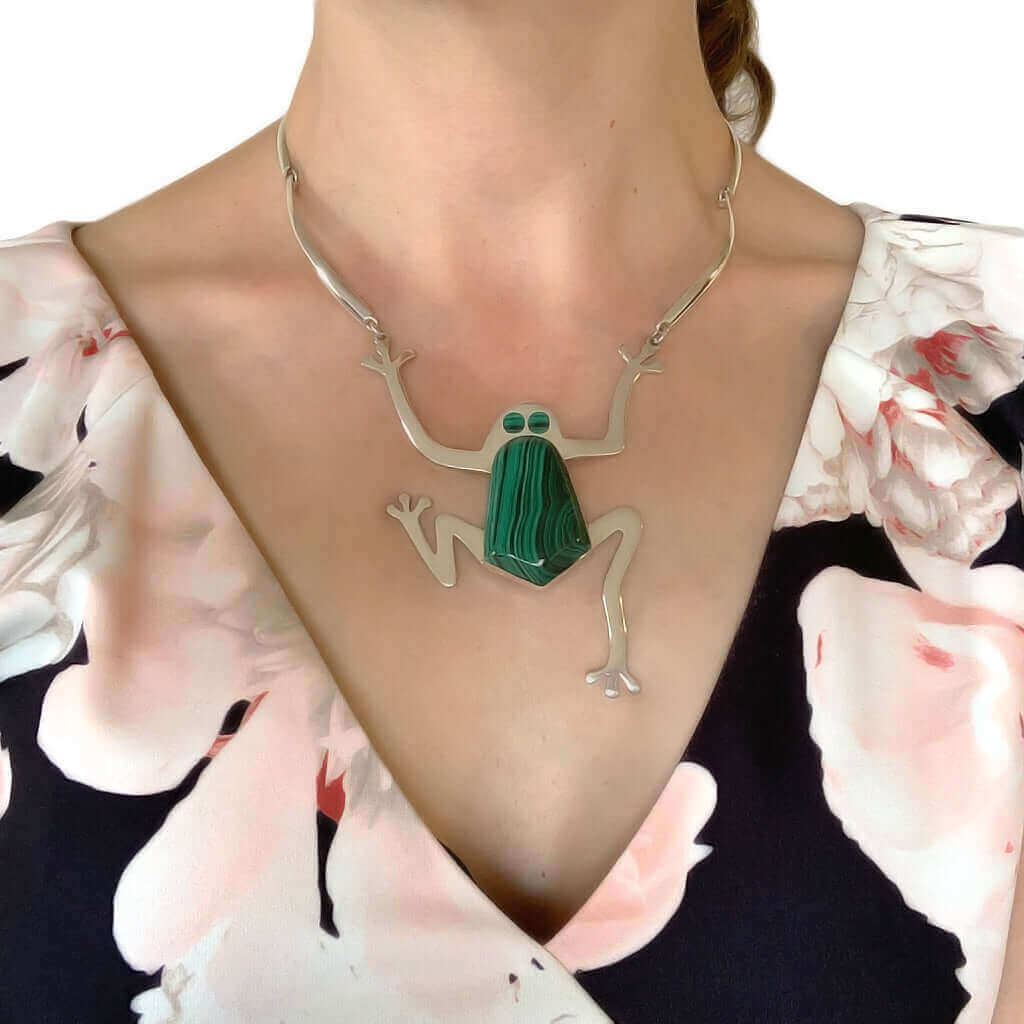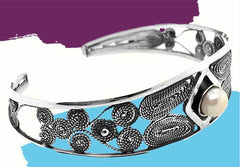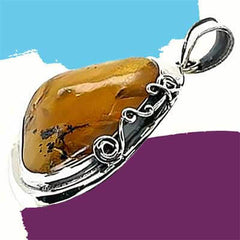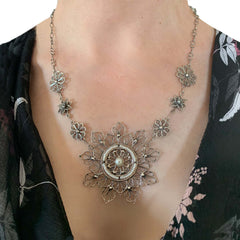
Pourquoi les bijoux mexicains sont-ils célèbres ?
Nichée dans le tissu brillant des différents paysages du Mexique se trouve une réserve abondante de ressources naturelles, chacune étant un monument à la grande beauté et à la diversité du pays.
Le Mexique abrite une grande variété d’environnements, des déserts magnifiques aux forêts à couper le souffle, des belles montagnes aux rivières cristallines et aux mers sans limites.
Le Mexique dispose d'une abondance considérable de ressources naturelles, notamment d'argent, un métal précieux dont il est le leader mondial de la production depuis de nombreuses années. Son secteur agricole est en plein essor, avec des produits comme l'avocat, le maïs, les pommes de terre, les tomates et le cacao. La richesse du Mexique s'étend également à un élevage florissant et à des zones de pêche abondantes, ce qui en fait une terre d'opportunités et de prospérité.
Le Mexique est également un véritable trésor de patrimoine culturel, avec une grande diversité d'artisanat, la joaillerie y occupant une place particulière. De tous les coins de cette nation dynamique proviennent des techniques et des matériaux uniques pour la décoration, créant des pièces qui capturent la beauté tout en entretenant des liens profonds avec la tradition et l'histoire.
En tant que personne ayant plus d'une décennie d'expérience dans l'industrie de la bijouterie, j'aimerais consacrer cet espace à la présentation des différents types de bijoux artisanaux mexicains. J'explorerai leurs origines, leurs caractéristiques et des exemples de leur savoir-faire exquis, offrant un aperçu de cette tradition riche et dynamique.
Filigrane d'Oaxaca, du Chiapas et du Yucatan
Le filigrane est une technique ancienne, dont l'utilisation a été prouvée par de nombreuses civilisations à travers l'histoire. On pense cependant qu'il a été spécialement développé et perfectionné par des civilisations comme les Phéniciens, les Grecs et les Égyptiens de l'Antiquité. Ces cultures utilisaient le filigrane pour créer des motifs élaborés dans des bijoux et des objets ornementaux en métal. La méthode s'est ensuite étendue à d'autres régions et cultures, chacune d'entre elles ayant apporté ses propres inventions et caractéristiques distinctives.
Originaires de l'État d'Oaxaca, dans le sud du pays, les bijoux en filigrane se caractérisent par des motifs complexes. Cette technique ancienne remonte à l'époque préhispanique et son savoir-faire a été transmis de génération en génération par des artisans qualifiés.
Les orfèvres qui se consacrent au filigrane passent leurs journées entre les fils d'or et d'argent, dessinant avec eux des dessins délicats comme de la dentelle. Ils manipulent habilement les fils, les entrelacent, les soudent et les fixent sur une base métallique, créant ainsi des œuvres d'art exquises.

Les filigranes des différents États du Mexique se distinguent par l'épaisseur des fils d'argent ou d'or utilisés. Le filigrane du Yucatan se distingue des autres styles, comme celui d'Oaxaca, par sa composition nettement plus dense.
La technique du filigrane est un procédé complexe qui requiert une précision méticuleuse au millimètre près. Elle confère à chaque pièce une personnalité authentique et irremplaçable, une qualité qui dépasse les capacités de toute machine.

Bien que le filigrane soit traditionnellement associé à ses origines à Oaxaca, au Yucatán et au Chiapas, Taxco possède également des pièces en filigrane de qualité supérieure fabriquées par des artisans qualifiés, comme ce magnifique bracelet en argent avec perle.
Les exemples de bijoux en filigrane comprennent de superbes boucles d'oreilles ornées de motifs floraux complexes, des bracelets finement tissés présentant des motifs géométriques et des colliers ornés de délicates perles en filigrane.
Bijoux en ambre du Chiapas
L'ambre, une résine fossile appréciée pour sa transparence et sa brillance remarquables, se trouve principalement dans les hautes terres du nord et du centre du Chiapas, en Méso-Amérique.
Surnommée « Ambre du Chiapas », cette pierre semi-précieuse d’origine végétale est utilisée sous diverses formes, notamment dans les bijoux, les œuvres d’art et les objets religieux.
Depuis l'Antiquité, l'ambre est très apprécié dans la région pour ses qualités ornementales et comme moyen d'échange.

L'ambre du Chiapas diffère de l'ambre de la Baltique par son procédé d'extraction. Alors que l'ambre de la Baltique se trouve souvent près de la surface, l'ambre du Chiapas est extrait de mines souterraines. Cette distinction contribue à la large gamme de couleurs de l'ambre du Chiapas, influencée par différents degrés d'oxygénation et d'exposition à la lumière tout au long de sa formation.
Les artisans exploitent habilement les propriétés et les teintes uniques de l'ambre dans leur travail. Le processus artisanal traditionnel comprend plusieurs étapes : la sélection des pierres brutes, la détermination de leur utilisation, le façonnage et la découpe aux formes souhaitées, le polissage avec du papier de verre et de la pâte brillante, le nettoyage méticuleux et enfin le montage des pierres dans des métaux précieux pour créer des pièces exquises.
Les bijoux en ambre du Chiapas sont disponibles sur les marchés locaux tels que le Mercado de Santo Domingo à San Cristóbal de las Casas ou dans les boutiques spécialisées de tout l'État. Chaque pièce reflète les caractéristiques uniques de l'ambre du Chiapas, avec ses tons chauds et éclatants et ses inclusions naturelles, témoignant du riche patrimoine culturel et de la maîtrise artisanale de la région.
 À Taxco, les artisans fabriquent avec brio de superbes bijoux en argent ornés d'ambre du Chiapas, créant une combinaison gagnante qui allie l'expertise affinée à Taxco au fil des ans à la beauté captivante de l'ambre du Chiapas. L'ambre du Chiapas détient notamment le statut prestigieux d'être l'un des 18 produits d'appellation d'origine officiellement reconnus au Mexique, soulignant à la fois sa qualité exceptionnelle et son origine unique.
À Taxco, les artisans fabriquent avec brio de superbes bijoux en argent ornés d'ambre du Chiapas, créant une combinaison gagnante qui allie l'expertise affinée à Taxco au fil des ans à la beauté captivante de l'ambre du Chiapas. L'ambre du Chiapas détient notamment le statut prestigieux d'être l'un des 18 produits d'appellation d'origine officiellement reconnus au Mexique, soulignant à la fois sa qualité exceptionnelle et son origine unique. Bijoux Wixárika ou Huichol
L'art huichol est issu d'une tradition ancestrale qui trouve ses racines dans les visions vécues par les chamans huichols ou Wixárikas, provoquées par la consommation de peyotl. Les artisans interprètent ces visions et les transforment en œuvres d'art complexes réalisées à partir de perles et d'étamines.
Surnommé « l'art de rêver pour créer » par le peuple Huichol, leur expression artistique est intimement liée aux rituels quotidiens impliquant le cactus Peyote, vénéré comme une divinité. Dans cette plante sacrée se trouve la mescaline, un composé psychoactif censé stimuler la créativité et l'imagination, inspirant les motifs vivants encapsulés dans leur art.
Enrichi par une profonde dévotion religieuse, l'art huichol incarne une beauté énigmatique et vibrante, offrant un aperçu de ses origines anciennes. Il représente une fusion de styles traditionnels et contemporains au sein des arts populaires et folkloriques.
Les bijoux Huichol ou Wixárika, réputés comme un exemple éminent de bijoux mexicains, sont l'une des formes de parure les plus reconnues et les plus répandues au Mexique. Caractérisées par des perles multicolores vibrantes remplaçant les matériaux traditionnels comme les graines, les pierres et les coquillages, ces créations sont incomparables et englobent une gamme variée d'accessoires.

Fabriqué par des artisans issus des communautés indigènes nichées dans les régions du centre-ouest du Mexique, en particulier dans la Sierra Madre occidentale, le processus complexe de fabrication de perles peut prendre une à deux semaines. Guidés uniquement par une aiguille et un fil, ces artisans qualifiés fabriquent des boucles d'oreilles, des pendentifs, des colliers, des bagues, des bracelets et des joncs, chaque pièce témoignant de leur riche héritage culturel et de leurs prouesses artistiques.
Bijoux Ocoxal
L'ocoxal, les aiguilles de pin, est un matériau naturel que, grâce à la patience et à l'ingéniosité, les habitants de l'État de Mexico ont appris à manipuler habilement, donnant lieu à la fabrication d'objets de couleur brune imprégnés d'un arôme distinctif et incomparable.
Le processus de production commence par la collecte des aiguilles de pin. Les artisans s'aventurent dans la forêt pour sélectionner soigneusement des aiguilles qui possèdent des caractéristiques spécifiques : elles doivent être épaisses, solides et longues pour éviter les cassures.
Une fois récoltées, les aiguilles sont trempées dans l'eau et lavées dans une cuve avant d'être étalées pour sécher sous les rayons du soleil, les préparant ainsi à l'utilisation.

Le tissage des aiguilles d'ocoxal est réalisé avec minutie à l'aide de fils de chanvre, ce qui nécessite une patience considérable. Ce processus complexe permet de fabriquer une grande variété d'articles, notamment des porte-serviettes, des bols à fruits, des corbeilles à pain, des vases, des plateaux, des pots à crayons et même des pots à tequila.
Avec une créativité sans limites, les artisans peuvent également fabriquer des boîtes à bijoux, des boucles d'oreilles et des colliers à partir de ces matériaux polyvalents.
Bijoux en argile noire
Parler de l'État d'Oaxaca, c'est évoquer une terre pleine de charme, de couleurs vibrantes et de traditions profondément enracinées. À l'intérieur de ses frontières, les coutumes, la musique, la cuisine et une riche histoire convergent, s'entrelaçant pour façonner une culture syncrétique qui incarne à la fois l'essence du passé et le dynamisme du présent. C'est un royaume où l'art s'épanouit sous une myriade de formes, insufflant à chaque recoin un sens et une identité.
Les artisans, maniant l'eau et l'argile comme outils élémentaires, façonnent la poussière de la terre de leurs seules mains, guidés par les impératifs de l'imagination et du cœur. Cet acte devient un dialogue sacré, une communion avec le divin et un reflet de l'esprit de la communauté.
Fabriquer de l'argile, c'est se lancer dans un voyage mystique, qui commence par le nettoyage rituel de la matière pour la purifier des impuretés et des pierres. Une fois nettoyée, l'argile est délicatement trempée, ce qui lui permet de céder au toucher. C'est à ce moment que l'enchantement se déploie, lorsque la poussière inerte prend vie, façonnée, moulée et imprégnée de vitalité par les mains de l'artisan, alimentée par l'imagination, la créativité et la technique.

Une fois terminée, la pièce subit un dernier rituel : un léger passage d'une éponge humide pour affiner sa surface par barbouillage, sgraffite ou grattage. Son éclat brillant, obtenu grâce au polissage méticuleux au quartz, est renforcé par le processus de cuisson sur du bois de chêne. Elle subit une cuisson à haute température dans un four souterrain entièrement fermé, créant un environnement appauvri en oxygène. Pour y parvenir, il faut sceller toutes les entrées avec de la boue.
Au cours de ce processus, une fumée dense se forme, imprégnant les pièces et leur conférant la

teinte noire caractéristique.
Les bijoux en argile noire fabriqués à Oaxaca respirent l'unicité, l'élégance et l'originalité. Chaque pièce est soigneusement moulée à la main, ce qui rend chaque bijou authentique et unique en son genre.
Bijoux en haricots et graines
Une autre approche artisanale de la fabrication de bijoux consiste à utiliser des graines indigènes de la région où elles sont fabriquées. Par exemple, des boucles d'oreilles et des colliers peuvent être fabriqués à partir d'une variété de graines telles que des haricots, grains de café torréfiés, graines de jacaranda, fruits secs, pour n'en citer que quelques-uns.
Les bijoux fabriqués à partir de fèves et de graines sont une expression du lien du Mexique avec la terre. Ils constituent une forme unique de parure qui célèbre l'héritage agricole du pays. Les artisans de régions comme le Chiapas et Oaxaca transforment ces matériaux modestes en bijoux magnifiques et respectueux de l'environnement.

Les bijoux fabriqués à partir de haricots et de graines sont disponibles sur les marchés locaux et dans les coopératives artisanales du Mexique, chaque pièce reflétant la beauté naturelle des matériaux utilisés. Des colliers colorés en haricots et des boucles d'oreilles en graines aux bracelets en graines finement tissés, ces pièces mettent en valeur la créativité et l'ingéniosité des artisans mexicains.
Bijoux en argent
Réputés dans le monde entier pour leur savoir-faire exquis et leur beauté intemporelle, les bijoux en argent de Taxco sont le reflet fidèle de la riche tradition d'orfèvrerie du Mexique. Située dans l'État de Guerrero, Taxco était une plaque tournante de la production d'argent avant même l'ère coloniale, les artisans continuant à créer des pièces époustouflantes en utilisant des techniques traditionnelles.
Bien que Taxco se distingue comme un centre important d'artisanat de l'argent, d'autres régions se vantent également d'une production importante d'argent, comme Mineral del Monte et Real del Monte à Hidalgo, Sombrerete à Zacatecas, Real de Catorce à San Luis Potosí, ainsi que Yucatán et Puebla.

Taxco, avec sa riche tradition remontant à l'époque préhispanique, est devenue un centre névralgique de l'artisanat de l'argent. L'héritage de la ville en matière d'argent s'est particulièrement épanoui dans les années 1930, donnant naissance à une gamme de modèles intemporels. Malgré la menace constante posée par les bijoux fabriqués à la machine, ces modèles continuent d'être méticuleusement fabriqués par des mains expertes à Taxco, préservant ainsi l'art, l'héritage et la grandeur des bijoux mexicains.
Préserver la tradition : un hommage aux bijoux artisanaux mexicains
En parcourant le monde diversifié des bijoux mexicains, il apparaît clairement que chaque technique est porteuse d'une histoire riche et d'une signification culturelle. Du filigrane complexe d'Oaxaca aux perles vibrantes de l'ouest du Mexique, ces pièces ne sont pas de simples accessoires mais des symboles de tradition et d'artisanat.
Chez Nueve Sterling, je m'efforce de célébrer ce riche héritage en apportant à votre porte les bijoux en argent sterling exquis et authentiques de Taxco. Chaque pièce de ma collection rend hommage à l'héritage des artisans mexicains, vous offrant un précieux souvenir de leur art et de leur culture qui perdurera pendant des générations.
Que vous soyez captivé par l'élégance intemporelle de l'argent de Taxco ou intrigué par l'ingéniosité des bijoux en aiguilles de pin, je vous encourage à explorer la beauté et le savoir-faire des bijoux mexicains. Chaque pièce recèle une histoire unique qui attend d'être découverte. Si jamais vous avez l'occasion d'acquérir l'une de ces exquises créations artisanales, je vous invite à la saisir. Non seulement vous vous parerez de beauté, mais vous contribuerez également à la préservation des riches traditions artisanales du Mexique. C'est une chance précieuse de faire partie de quelque chose de vraiment spécial.
Partager
I have a Mexican charm bracelet. I’m interested in finding out what the charms mean. Can you give me any advice where I could look? Thanks, Debby


